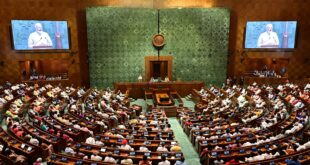Dr.Seema Javed
 The year 2020 will always be referred as the year of the great pandemic in future. But while the public health emergency dominated headlines, our era’s other big headache, climate change, also found prominence in the footnotes. While the world floated into the Paris Agreement era, developing & developed world equally tried to contend with the economic fallout of COVID-19.
The year 2020 will always be referred as the year of the great pandemic in future. But while the public health emergency dominated headlines, our era’s other big headache, climate change, also found prominence in the footnotes. While the world floated into the Paris Agreement era, developing & developed world equally tried to contend with the economic fallout of COVID-19.
The world is not yet on track to avoid dangerous, irreversible climate change. But in the five years since the Paris Agreement, progress on low-carbon solutions and markets has been much faster than many realise. And SYSTEMIQ’s latest report finds that low-carbon solutions could progress rapidly through the 2020s.
“It is clear the global long-term goal of Paris – net zero GHG emissions by mid-century – is now the reference point for governments and financial actors”, says Laurence Tubiana, CEO, European Climate Foundation. “World leaders started a journey in 2015 and now is the time to accelerate.
This momentum is coming from countries, companies and investors. By moving further and faster, zero-carbon industries can be scaled in the 2020s, creating sustainable growth and more resilient economies. In sectors from renewable power, to local food economies and land restoration, the growth of net-zero economies in the 2020s can create over 35 million jobs globally. These are needed more than ever in the post-COVID recovery.

Several large economies like China, Japan, South Korea , Cannada, UK, Europe all have announced intent to undertake decarbonisation pathways that achieve net-zero emissions by 2050 or 2060. While India’s context and developmental agenda expose unmistakable fault lines in the search for an equitable and fair transition to clean energy.
A rapid transition to clean energy in fast-developing Southeast Asia is essential to slowing climate change. Yet In the years since the Paris Agreement was signed, India has slowly, but surely, earned the distinction of being among the best performing large economies when it comes to climate action. While the energy sector has been the primary front of assault in India’s low carbon push, its developmental agenda, which includes ensuring improved energy access to millions of energy-scarce regions, puts an added spin to the implications of its shift to low carbon energy. The prerogative of ensuring the delivery of modern services and improving energy access makes India’s clean energy transition a balancing act unlike that seen in the developed world.
Climate Transparency Report 2020, found that apart from India, which has invested heavily in renewables, no other country, including top emitters US, EU and China, are on track to fulfill their Paris commitments.
In the next decade renewables are set to double and coal power to halve – but seven countries will cause the EU to miss its emissions targets. Analysis by climate think tank Ember reveals the seven countries that are blocking Europe’s electricity transition. Together they will be responsible for 80% of the EU’s power sector emissions by 2030 due to their reliance on coal and fossil gas and insufficient deployment of zero-carbon electricity. As a result, the EU is not on track to deliver the Commission’s recommended 55% reduction in total emissions by 2030, let alone the EU Parliament’s target of 60%.
This past year witnessed a fall in solar tariffs. In India, they dropped to less than ₹2. The year also revealed a big appetite among domestic and foreign investors to build renewable infrastructure despite COVID-19. The pandemic added to the decline in the capital cost of solar and the cost of funding and hastened the switch from polluting coal power to renewable energy in India. The country set up a new RE target of 220 GW by 2022.
One of the major advantages of employment in the renewable energy sector over the coal sector is the socio-economic benefits – this includes higher income, fixed salaries, healthcare benefits and skill-building opportunities. which can benefit India’s poverty-stricken rural economy. At least 3.2 million people can be employed in this sector by 2050 – that is five times more people than what the fossil-fuel sector employs currently.
The path to a clean energy future looks bright for India .
(Author is Environmentalist, Independent Journalist & Communication Consultant)
 Jubilee Post News & Views
Jubilee Post News & Views





